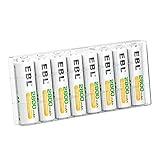This page may have Commerce Content. If you buy something from our posts, we may get a small share of the sale. Click here for more.
Editor & Article Writer for Outdoor Wilds
As an Amazon Associate I earn from qualifying purchases. Thank you for helping to support the site.
Best AA Batteries for Trail Cameras
The majority of modern trail cameras are powered by AA batteries. Deciding what’s the best AA batteries for trail cameras can throw up a whole load of statistics, numbers and cost comparisons.
This article is here to provide a quick and easy to follow guide to allow you to make an informed decision on the best batteries for your trail camera in terms of battery performance and cost over time.
There’s 3 main types of AA batteries to choose from. I’ll take a quick look at the advantages and disadvantages of each. I’ll then recommend the best brand of battery for each type.
Popular Posts
Last update on 2025-05-02 / Affiliate links / Images from Amazon Product Advertising API
Standard Alkaline
Last update on 2025-05-02 / Affiliate links / Images from Amazon Product Advertising API
You’ll see these for sale everywhere you go from gas stations to supermarkets. Generally speaking alkaline batteries are great for low power consumption items, such as TV remotes, clocks etc.
Trail cameras in standby mode don’t consume much power, they are low drain, but as soon as they detect movement, especially at night, they require a lot of power to illuminate the picture and record images onto an SD card.
Advantages
Alkaline batteries are cost effective in warmer temperatures. The initial cost is low and they’ll power your trail cam until the voltage drops below 1.2 volts per cell.
Disadvantages
I’d suggest avoiding using alkaline batteries in temperatures below 32 degrees fahrenheit. The electrical chemical reactions [1] slow down in colder temperatures which make them a bad choice for this reason.
The voltage output drops at a steady rate. What this means is the brightness of the IR flash and trigger speed drop in performance as the batteries drain over time.
Best Performing Alkaline Batteries
If you choose to go for alkaline batteries, the 2 best performing brands are Energizer Max and the Duracell Ultra Power.
Best Deals – Energizer Batteries
Last update on 2025-05-02 / Affiliate links / Images from Amazon Product Advertising API
Best Deals – Energizer Batteries
Last update on 2025-05-02 / Affiliate links / Images from Amazon Product Advertising API
Lithium Batteries
Last update on 2025-05-02 / Affiliate links / Images from Amazon Product Advertising API
The initial cost of lithium batteries can be up to 3 times that of alkaline, but the capacity is far greater and they’ll provide a constant voltage output throughout the life of the battery. So no decrease in performance over time from your trail camera with this type of battery.
Advantages
High capacity batteries that will power a trail camera far longer than any alkaline batteries will.
You won’t see a drop in performance from your camera. The camera will operate fully for the lifetime of the batteries and then stop working completely.
Cold weather doesn’t affect their performance in the same way as it does with alkaline cells. They can operate in temperatures from -40F to 140° Fahrenheit.
Disadvantages
Lithium batteries are expensive as an initial outlay. They do become more cost effective over time as they last far longer.
The same as alkaline, they end up in landfill once they have drained, so not a great choice for environmental reasons.
Lithium Battery Recommendation
Energizer Ultimate Lithium Batteries are the brand of choice. Arguably the best AA batteries on the market, but at a price.
Last update on 2025-05-02 / Affiliate links / Images from Amazon Product Advertising API
Rechargeable
Last update on 2025-05-02 / Affiliate links / Images from Amazon Product Advertising API
A lot of people will say not to use rechargeable batteries to power trail cameras. But not all rechargeable batteries are the same.
If you’re thinking of using rechargeable batteries then you need as high capacity, slow voltage drain batteries as possible.
Advantages
The cost saving here is massive. Even after 2 or 3 charges, they will have paid for themselves compared to other battery types.
A quality rechargeable battery does have a very high capacity that’s on par with a lithium battery. So they will last a lot longer than alkaline batteries.
Cold weather performance is pretty good. They’re not as effective as lithium in cold temperatures. They will not suffer any performance drop until the temperature drops into single figures.
Disadvantages
Most brands of rechargeable will only output around 1.2 volts which is not high enough for a lot of trail cameras to function.
A fully charged set placed inside a trail camera will start to self discharge immediately and will only last around 90 days regardless of usage.
Best Rechargeable Battery Brand
The EBL 2800mAh Ni-MH rechargeable batteries are my choice for powering trail cameras. They are high capacity at 2800mAh with a minimum voltage output around 1.27 volts.
 EBL AA Rechargeable Batteries 2800mAh Ready2Charge... $25.99
EBL AA Rechargeable Batteries 2800mAh Ready2Charge... $25.99  EBL AA Rechargeable Batteries 1.2V 2500mAh High... $32.59
EBL AA Rechargeable Batteries 1.2V 2500mAh High... $32.59 Last update on 2025-05-02 / Affiliate links / Images from Amazon Product Advertising API
Last update on 2025-05-02 / Affiliate links / Images from Amazon Product Advertising API













